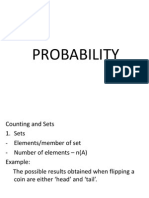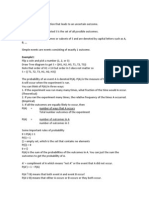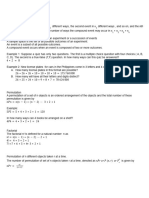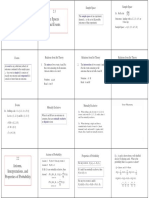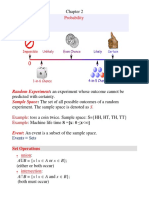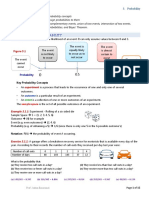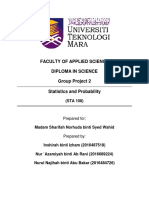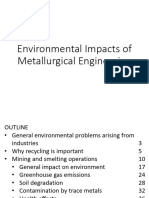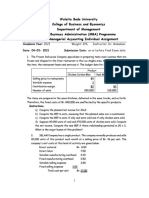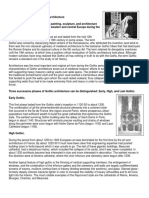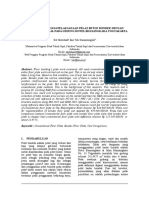STA 112: PROBABILITY I
Course Contents
Permutation and combination. Concepts and principles of probability. Random variables.
Probability and distribution functions. Basic distributions: Binomial, geometric, Poisson,
normal and sampling distributions; exploratory data analysis.
1. Permutations
A permutation is an arrangement of items in which order matters.
1.1 Permutation of n Different Objects (All Taken)
If all n objects are arranged at once, the total number of possible arrangements is: n!
Example 1:
In how many ways can we rearrange the letters in the word CAT?
3! = 3 × 2 × 1 = 6 ways
Words: CAT, CTA, ACT, ATC, TAC, TCA
Example 2:
How many ways can we rearrange the letters in the word MATH?
4! = 4 × 3 × 2 × 1 = 24 ways
1.2 Permutation of n Objects Taken r at a Time
The number of ways to arrange r objects out of n , when order matters, is:
n!
pr
n
n r !
Where, n = total number of objects available,
r = number of objects to be arranged
n! n n 1 n 2 1 is called n factorial.
Example 3:
How many ways can we pick 2 letters from the word CAT?
3!
pr = 3P2 3 p2 6ways
n
3 2 !
Arrangements: CA, AC, AT, TA, CT, TC
1
�Example 4:
If there are 10 people, how many ways can we choose a President, Vice President, and
Secretary?
10!
pr = p3 720ways
n 10
10 3!
1.3 Permutations with Repetition (Alike Items)
If some items are repeated, the number of distinct permutations is:
n!
n1 ! n2 ! nk !
Where n1 ! n2 ! nk ! are the counts of alike items.
Example 5:
How many ways can we rearrange the letters in the word BALLOON?
Letters = 7, B:1, A:1, L:2, O:2, N:1
7! 5040
1260ways
1!1! 2! 2!1! 4
Example 6:
How many ways can we arrange the letters of the word STATISTICS?
Total letters = 10; S: 3, T: 3, A: 1, I: 2, C: 1
10! 3,628,800
50, 400ways
3! 3!1! 2!1! 72
2. Combinations
A combination is a selection of items in which order does not matter.
2.1 Combination of n Objects Taken r at a Time
n!
Cr
r ! n r !
n
Example 7:
From the word CAT, how many combinations of 2 letters can we form?
2
� 3!
C2 3ways
2! 3 2 !
3
Combinations: CA, CT, AT
Example 8:
From a group of 6 people, how many ways can we select a committee of 3?
6!
6 C3 20ways
3! 6 3!
Example 9:
How many ways can we choose 4 students from 10?
10!
10 C4 210ways
4!10 4 !
2.2 Relationship Between Permutation and Combination
n Pr n Cr r !
This shows permutations count arrangements, and combinations count selections.
3. Practice Exercises
Permutation Exercises
1. In how many ways can the letters of the word EXAM be arranged?
2. How many ways can 4 books be arranged on a shelf from a collection of 6 books?
3. A lock uses 3 digits from 0 to 9. How many 3-digit PINs are possible if digits
cannot repeat?
4. How many distinct arrangements can be made from the word SUCCESS?
5. How many 3-letter arrangements can be formed from the letters of the word
SCHOOL?
Combination Exercises
1. From 8 players, how many ways can a team of 5 players be selected?
2. A committee of 4 is to be chosen from 6 men and 5 women. How many ways can
this be done if the committee must include 2 men and 2 women?
3. From the word MANGO, how many 3-letter combinations can be made?
4. How many different combinations of 2 cards can be drawn from a deck of 52
cards?
5. A student must choose 3 electives from 7 courses. In how many ways can this be
done?
3
�Basic Probability Concepts
1. Random Experiment
A random experiment is an operation whose outcome depends on chance. It leads to one
of several possible outcomes where the result of a particular trial is not known in
advance.
Examples:
• Tossing a fair coin: The result could be either a head (H) or a tail (T), but which one
occurs is not known in advance.
• Throwing a die: Possible outcomes are 1, 2, 3, 4, 5, or 6.
2. Outcome / Sample Point
An outcome (or sample point) is the result of a single trial of an experiment.
3. Event
An event is a possible outcome or a set of outcomes of an experiment. It is usually
denoted by uppercase letters.
Example: Getting an even number when rolling a die (i.e., event A = {2, 4, 6}).
4. Sample Space
The sample space is the set of all possible outcomes of an experiment. It is usually
denoted by S or Ω.
Example: When tossing a die once, S = {1, 2, 3, 4, 5, 6}.
Each element of the sample space is called a sample point.
5. Independence of Events
Two or more events are said to be independent if the occurrence of one does not affect
the probability of occurrence of the others.
Example: Tossing a coin and rolling a die — the result of the coin toss does not affect the
die outcome.
6. Dependent Events
Events are dependent if the outcome or occurrence of one affects the probability of the
others.
4
�Example: Drawing two cards from a deck without replacement — the first draw affects
the second.
7. Mutually Exclusive Events
Two events are said to be mutually exclusive (or disjoint) if they cannot both occur at the
same time.
That is, they have no elements in common.
Example:
A = {E1, E2, E3}, B = {E4, E5, E6}
A ∩ B = ∅ ⇒ A and B are mutually exclusive.
8. Definition of Probability
Probability is a measure of the likelihood of occurrence of an event. If an event is certain
to occur, its probability is 1; if it is impossible, the probability is 0.
This means that all probabilities lie between 0 and 1.
The classical definition of probability is:
m
P A
n
Where:
m = number of favorable outcomes
n = total number of possible outcomes
LAWS OF PROBABILITY
1. Basic Probability Rules
Let A be an event in sample space S, then:
i. P A 0
ii. PS 1
iii. If A1, A2, are mutually exclusive: P A1 A2 P Ai
iv. 0 P A 1
v. P A ' 1 P A (complement rule)
5
�2. Addition Rule (OR)
Used when OR connects two or more events.
For any two events A and B: P(A ∪ B) = P(A) + P(B) - P(A ∩ B)
If A and B are mutually exclusive: P(A ∪ B) = P(A) + P(B)
Example 1
A die is rolled. What is the probability of getting 4 or 6?
P(4) = 1/6, P(6) = 1/6
Since 4 and 6 are mutually exclusive: P(4 ∪ 6) = 1/6 + 1/6 = 2/6 = 1/3
Example 2
In a survey of 20 people:
6 own a Peugeot, 9 own a Toyota, 3 own both.
P(A ∪ B) = 6/20 + 9/20 - 3/20 = 12/20 = 3/5
Example 3
Find probability that a number from 5 to 25 is a multiple of 3 or 5.
Multiples of 3: 7, Multiples of 5: 5, Overlap: 1
P(3 ∪ 5) = 7/21 + 5/21 - 1/21 = 11/21
3. Multiplication Rule (AND)
Used when AND connects two events.
P(A ∩ B) = P(A) × P(B|A)
If A and B are independent: P(A ∩ B) = P(A) × P(B)
Example 4
P(Math) = 0.64, P(Eng) = 0.48 (independent)
P(Math ∩ Eng) = 0.64 × 0.48 = 0.3072
6
�Example 5
Roll a die and toss a coin. P(4 and heads)?
P(4 ∩ H) = 1/6 × 1/2 = 1/12
4. Conditional Probability
Conditional probability is the probability of an event occurring given that another event
has already occurred. If A and B are two events, the conditional probability of A given B
(denoted P(A|B)) is defined as:
P A B
P A B , provided that P B 0 .
P B
This formula tells us how the probability of event A is affected when event B is known to
have occurred.
- P A B : Joint probability that both events occur.
- P B : Probability that event B occurs.
- P A B : Probability of A happening under the condition that B has happened.
Example 6
In a certain company, two training workshops are available in a month. An employee has
0.35 probability of been selected to attend the first, 0.25 probability of attending the two
workshops. What is the probability that an employee selected will attend the second
workshop?
Let M 1 be the event that the employees will attend the first workshop.
Let M 2 be the event that the employees will attend the second workshop.
P M1 0.35 , P M1 M 2 0.25
P M1 M 2
P M1 M 2
PM2
0.25
0.714
0.35
7
�5. Complement Rule
Used when it’s easier to calculate the chance of an event not happening.
P(A') = 1 - P(A)
Example 7
P(rain) = 0.3 ⇒ P(no rain) = 1 - 0.3 = 0.7
References
1. Hogg, R. V., McKean, J., & Craig, A. T. (2019). Introduction to Mathematical
Statistics. Pearson.
2. Sheldon Ross (2014). A First Course in Probability. Pearson Education.
3. Grinstead, C. M., & Snell, J. L. (1997). Introduction to Probability. American
Mathematical Society.
